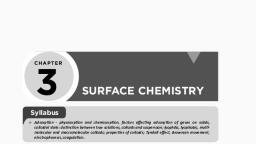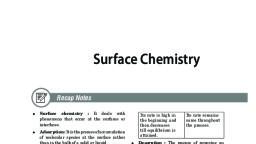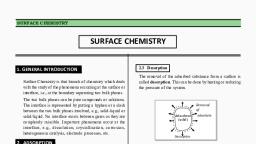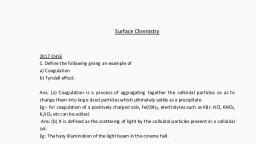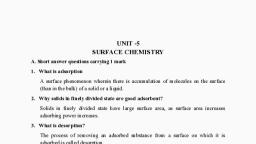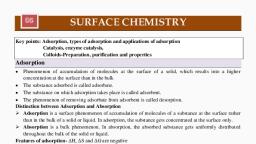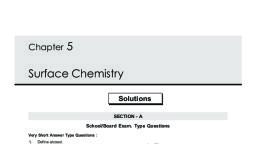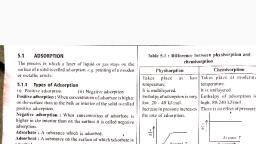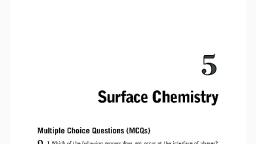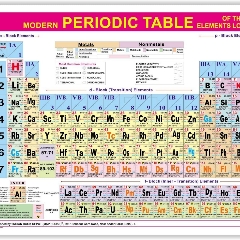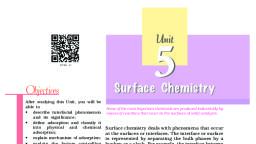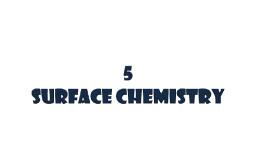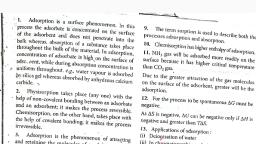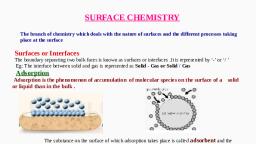Page 1 :
K.D.CLASSES. DAUND., Contact No,-9022341567, ADSOROTION COLLOIDS 2021-22, 01), dispersed phase., A) Smoke, B) Leather, C) Clouds, D) Boot polish, colloldal system contains solld as the, Disperaion Dispersed, phase, solid, medium, C), liquid, Dispersion Disperaed, medium, phase, liqui, iquid, colloidal system., D), 02) Fog is an esample of, A) liquid dispersed in gas, B) gas dispersed in gas, C) solid dispersed in liquid, D) solid dispersed in gas, 08) The following properly which is uned to, measure the rate of miigraton of sol particle., A) Electrophorgets, B) Electroosmosia, C) Drownian movement, D) Tyndall effeet, 03) An emulsion cannot be broken by, ) heating, II adding more amount of dispersion medium, ) freezing, M adding emulsilying agen, Choose the correct option., A) 1, Il and Il, B)Il and IV, C)I and II, D) II and Ill, on pue, 09) Homogeneous catalyais indiates that, A) all reaetantand products muat be in the eame, phade, D) the reactanta and the catalyst must be in the, wme phase, C) the composition of the reaction mixture must be, homogeneous throughout, heproducts and the catalyat must be in the, anhe phase, 04) The graph of log x/m v s. log P, for the, adsorption of a gas on a solid, is linear. What is the, slop of this graph?, A) log K, B) K, C) n, DI 1/n, 10) When a strong beam of light is passed through, Wcolloidal solution, what will happen with the, light?, A) It will be Bcattered, D) It will be reflected, C) It will be refracted, D) It will give a rainbow, 05) Choose the correct option: Fog is, system of, A) solid in gas, B gas in gas, C) liquid in gas, D) none of these, 11) Colloids can be purified by which of the, following techniques?, A) Bredic are method, B) Coagulation, C) Dialysis, D) Peptisation, 06) Ethylene on oxidation givesacetaldehyde., Which catalyst is used?, A) VOs, B) Pd/Al,O,, 12) Hardy-Schulze law implies that, A) higher the charge of coagulation ions greater its, coagulating power, having opposite sign of solution, B) disperse phase and dispersion medium must be, of the same sign, C) solution must have zero gold number, D) micelles coagulate in the presence of surfactan, C) Ag/Al,O,, D) No., 07) Whipped ofceam is an example of, Dispersion Dispersed, phase, liquid, 13) The colloidal solution of gelatin is called as, A) reversible sol, B) solvent loving sol, C) hydrophilic collold, D) all of these, medium, gas, A), Dispersion Dispersed, medium, phase, B), iquid, gas, 14), A) Adsorption of H, on Ni at high temperature, B) Adsorption of moisture on silica gel, is chemisorption., NEET, JEE-MAIN, MHT-CET-XI - New Syllabus (MH), D.CLASSES
Page 2 :
OAsorption of H on charcoal, DDehydration by anhydrous CaCl,, 15) The amoke is a colloidal sol of, Al gas dispersed in solid, B) solid dispersed in liquid, C solid dispersed in gas, D) gas dispersed in liquid, 24) Animal charcoal is used in decolourising colour, of liquids due to it is a good, A) adsorbent, B) adsorbate, C) oxidising agent, D) reducing agent, 25) Find out the mismatched pair., Disperaed Dispersed, medium, sold, Speific, Name, nalid sol, 16) Identify the characteristics of a catalyst., Al t initintes the reaction, B) It changes the equilibrium point, CIt alters the rate of reaction, D) It increases average kinetic energy of molecules, phase, solid, A), Dispersed Dispersed, Speific, Name, phase, medium, liquid, liguid, emulsion, 17) The migration of colloidal particle under the, influence of electric fleld towards an electrode is, called as, B), Dispersed Diapersed, phase, liquid, Speific, Name, medium, A) electro-osmosis, B electrophoresis, Tyndall effect, D Brownian movement, nerosol, C), Dispersed Dispersed, phase, Speific, Name, medium, gas, solid, foam, 18), AJ Soap + water, B) Protein + water, CRubber benzene, D) As,O, Fe(OH),, is an example of associated colloid., D), 26 Colloidal solution are not purified by, rechniques., A) electrodialysis, Bl dinlysis, OLeleotrophoresis, D utrafiltration, 191 What is the reason of Tyndall effect?, A) Scattering of light by colloidal particles, B) Reflection of light by colloldal particles, Polarization of light by colloidal particles, D) None of the above, 27) Mark the incorrect statement for, clectrophoresis., A) Electrophoresis is a useful method for finding, the charge of a solution, B) In electrophoresis, solution migrates eithers to, anode or to the cathode depending upon the, positively or negatively charged solution, C) Electrophoresis with a high potential is helpful, in destroying an emulsion, D) Colloids are uncharged particles and do not, migrate towards the electrodes when electric field, is applied, 20) What is the cod liver oil?, A Solution, B) An emulsion, C Colloidal solution, DJ Suspension, 21) Find out the wrong statementabout, chemisorption., A It involves the formation gf a compound on the, surface of the solid adsorbert, B It first increases with increase of temperature, and then decreases, CIt is apecific in nature, D It is reversible in rurc., 28), A) Blood, B) Urea, C) Sugar, D) NaCl, is a natural colloid., is adsorbed inmaximum amount by, 22), activated charcoal., Al O,, B Co,, 29) Mark the correct one according to Freundlich, adsorption isotherm., A)aP, D) N,, B), ap., m, 23) Elue colour of water in sea is because of, A refraction blue sky by water, B refraction of blue light by impurities, Cacattering of light by water, D) none of the above, m P, D), ap/n, 30) Chemisorption does not depend on which of, NEET, JEE-MAIN, MHT-CET-XI - New Syllabus (MH), KD.CLASSES, xE xE xE E
Page 3 :
owing factor?, AJ Temperature, B Pressure, C) Nature of adsorbate, D) Nature of adsorbent, 37) The stability of lyophilic colloid is because of, A) a layer of medium of dispersion on their, particles, B) charge of their particles, C) the smaller size of their particles, D) the large size of their particles, 31) Mark the correct statement for Tyndall effect., A) Scattering and polarising of light by small, suspended particles is called Tyndall effect, B) Tyndall effect of colloidal particles is due to, dispersion of light, C) Tyndall effect is due to refraction of light, D) Zig-zag motion of suspended particles, 38) The volumes of gases HCH CO, and NH,, adsorbed by 1g of charcoal at 288 Kare in which o, the following order?, A) CO, > NH, >H, > CH, B) H, > CH, > co, > NH, C) CH, > CO, > NH H,, D) NH, >CO, > CH > H, 32) The charge on colloidal particles is because of, A) very small size of particles, B) presence of electrolyte, C) adsorption of ions from the solution, D) none of these, 39) Tyndall effect would be seen in a, A) solvent, B) solution, C) colloidal-solution, D) precipitate, 33) What is catalysis?, A) It is a phenomenon in which heat is evolved in a, chemical reaction, B) It is a phenomenon in which asubstance alters, the speed of the chemical reaction, C) It is a phenomenon in which the reaction is, induced by light, D) none of the above, 40) The separatuon of colloidal particles from thos, of molecular dimensions is called, A) Peptisation, B Dialysis, C) Pyrolysis, DI Photolysis, 34) What is the dispersion medium in gel?, A) Solid, B) Liquid, C) Gas, D) Water, 41What is colloidal sol?, A Suspension, B True solution, C) Heterogeneous sol, D) Homogeneous sol, 35) According to the adsorption theory of catalyst,, the speed of reaction increases due to, A) adsorption lowers the activation energy, 42) Adsorption plays an important role in, catalysis, A) Heterogeneous, B) Homogeneous, C) Positive, D) Negative, reaction, B) adsorption produces heat which increcases the, speed of the reaction, C) the concentration of reactant molecules at the, active centres of the catalyst becomes high due to, adsorption, D) in the process of adsorption, the activation, energy of the molecules become large, 43) What is the movement of dispersion mediu, under the influence of electric field?, A) Electrophoresis, B) Electrodialysis, C) Electro-osmosis, D) Cataphoresis, 36) Match the column corectly., Column II, Aerosol of liquid, 2, Calumn I, Smoke, 1., Aerosol of solid, Emuleion, Milk, 44) What is the process of peptization?, A) Purifying the colloidal sol, B) Precipitating the colloidal particles, C) Dispersing the precipitate into colloidal so, D) Movement of colloidal particles towards th, opposite charged electrodes, C., Butter, 3, Get, D Fog, 14, 2., 4, A), 45) Find out a heterogeneous catalysis., A) 2C,H,OH-, 3., 2., 4., 1, Conc H,SO, C,H;OC,H; +H,, A., 2., C), B) so, +0,, 1., 3., NO SO3, 4., B, C) 2C0+0,, NO, 3., 4., 1., D), NEET, JEE-MAIN, MHT-CET-XI - New Syllabus (MH), B)
Page 4 :
V,O SO3, D) SO, +02, 46) What is floculation of an electrolyte?, A) It is the amount of electrolyte in milligrams to, bring about ccoagulation of 10 ml of the colloidal, sol, B) It is the amount of electrolyte in grams required, to bring about coagulation of one litre of colloidal, sol, C) It is the amount of the electrolyte in millimoles, required to bring about the coagulation of 1 litre of, the collodial sol, D) It is the reciprocal of coagulating power, 47) Adsorption is observed in, A) chromatography, B) heterogeneous catalysis, C) homogeneous catalysis, D) all of the above, 48) The movement of colloidal particles, inder, applied electric current is called as, A) dialysis, B) electro dialysis, C) electrophoresis, D) none of theses, 49) Colloidal particles of soap sol in water are, A) positive charged, B) negative charged, C) neutral, D) unpredictable, 50) Adsorption isotherm of gases on solids give the, relation between which o f the following?, A) Amount of adsorbent per unit weight of, adsorbate and pressure, B) Volume of adsorbent and temperature, C) Amount of adsorbate per unit weight of, adsorbent and equilibrium pressure, D) Value of adsorbate and pressure, CLASSES. D






















